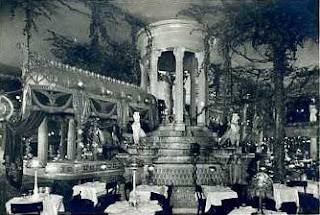New York as we know it is a grid city with logical planning of avenues and street, a modern depiction of a cityscape. It optimizes tiny Manhatten maximum spaces with many modern designs and fast-paced movement happening. But in the end, nothing’s perfect and especially for Rem Koolhas who wrote “Delirious New York”. His writing on New York is harsh, it’s a very impactful piece to provoke thinking. To start, he stated New York as unrealized failures, with an expression full of ecstasy. An overwhelming pack of man’s wants and need is the embodiment of what New York is, pushing itself to a point of disconnect with reality.
Coney Island: the experimentation of our wildest dreams. It is such awe, as a physical representation of man's wildest dreams. To our generation, Coney island seems like a dated park, compared to many more popular theme parks with the latest design such as Universal Studio at Singapore or Tokyo Disneyland. With our childhood movies and favorite characters brought to life, it’s more known and attractive. But after knowing a bit of Coney’s history and with the input on Delirious New York, the pure desire of men to reach our fantasy has never shone brighter in history with such an achievement for that time.
Skyscrapers are evidence of elevated desires, elevated lives. Life was becoming more enriched in this Fantasy Pragnitism. Each skyscraper a city within a city with no concern of the nearing buildings. It reflects our modern society, where people can be self-centered and be fully submerged in their own bubble. But at the same time, all these all lead to a bombastic mass of culture, a culture of congestion. Such hyperdensity is a beautiful merge of personalities and emotions, the hopes and dream place into one entity.
For our project, one of the complaints by locals is the increasing amount of foreign workers. Many locals are not happy with how such huge masses have come into our country. The safety of their community has wavered. And it seems that there’s no proper solution figured out.
The theory of skyscraper as a utopian device, that allows life to be secluded but sufficient by the same entity. In my opinion, the idea is tempting to allow all parties to survive and to be able to choose there respective culture or surroundings they want to be in. It does quite dissolve the tension but complete place them out of each other’s sight. Such a system seems to be immoral or prehistoric what if the communities were not meant to mix or not even willing to be exposed to, is it right to push on such a social burden on the locals? The increasing crime rate has affected the local Chinese community near Pasar Sungai Chua, and mainly it's snatching incidents and love scams. Don’t they have a right to be peace on their own land? But would this solve the issue of tension or just ignite a new way of disconnect to life?
1001749034 Gwendolyn Chan Mei Yee









